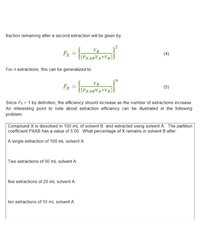
Introduction to Chemical Engineering Thermodynamics
8th Edition
ISBN: 9781259696527
Author: J.M. Smith Termodinamica en ingenieria quimica, Hendrick C Van Ness, Michael Abbott, Mark Swihart
Publisher: McGraw-Hill Education
expand_more
expand_more
format_list_bulleted
Concept explainers
Question
Need help figuring out these equations and problems, I need a guide to solve one so I can figure out the rest.

Transcribed Image Text:fraction remaining after a second extraction will be given by:
VB
Fx
((Px,ABVA+VB)
(4)
For n extractions, this can be generalized to:
VB
Fx
((Px,ABVA+VB))
(5)
Since Fx < 1 by definition, the efficiency should increase as the number of extractions increase.
An interesting point to note about extraction efficiency can be illustrated in the following
problem:
Compound X is dissolved in 100 mL of solvent B, and extracted using solvent A. The partition
coefficient PXAB has a value of 5.00. What percentage of X remains in solvent B after:
A single extraction of 100 mL solvent A
Two extractions of 50 mL solvent A
five extractions of 20 mL solvent A
ten extractions of 10 mL solvent A
Expert Solution
This question has been solved!
Explore an expertly crafted, step-by-step solution for a thorough understanding of key concepts.
Step by stepSolved in 3 steps

Knowledge Booster
Learn more about
Need a deep-dive on the concept behind this application? Look no further. Learn more about this topic, chemical-engineering and related others by exploring similar questions and additional content below.Similar questions
- A cube of metal is 1.32 cm on an edge. It has a mass of 21.3 g. Calculate the density of this metal cube. Show work for each step including the units in each step.arrow_forwardQUESTION 1 Later on in the course, you will learn how to use the Navier-Stokes equations to predict the flow behaviour of Newtonian fluids in various systems with fairly simple geometries. Below is a schematic for the pressure-driven flow of a Newtonian fluid in the annular space between two concentric cylinders - the inner cylinder has radius Ri and the outer cylinder has radius Ro. PO>PL • the applied pressure (AP) Four of your colleagues attempted to solve the Navier-Stokes equations to determine an expression for Q, the volumetric flow rate of fluid, in terms of the following parameters: the length of the annular space (Z) the viscosity of the fluid (μ) Unfortunately they each came up with a different expression for Q: Q TR² AP πR ΔΡ -|- -|- Q = 8μ L 8μ L * Ro Z AP -A1-(-)* 8μ L Ro ¹ (R₂) In 2R₁2R0 ¹-(₂)]²* ¹ (R₂) In Q TRAP 8μ L -(.*. R₁ Ro [p()] (R₂) Ro In 1- (+)²] ² (Ro R₁ In Using a dimensional analysis, determine which (if any) of the four might be the correct equation for Q.arrow_forwardI got 10^(-8) instead of 10^(-5) can someone tell me what I'm doing wrong or if my answer is correct?arrow_forward
- Write out the steps (including equations) for BUBL P, DEW P, BUBL T, and DEW T calculations using the modified Raoult’s law.arrow_forwardI need help sketching a concentration profile vs volume. I have already found the volume (which the work is showed in part a )I need help in part C, which is sketching the concentration. I initially thought It might just be a straight line, but I am not sure if I need to use levenspiel plot to calculate concentration. There is an equation in part C. I’m not sure if I can use that to sketch a concentration profile I just put it there. please help.arrow_forwardDescribe k-ε model with its advantages and disadvantages.arrow_forward
arrow_back_ios
arrow_forward_ios
Recommended textbooks for you
 Introduction to Chemical Engineering Thermodynami...Chemical EngineeringISBN:9781259696527Author:J.M. Smith Termodinamica en ingenieria quimica, Hendrick C Van Ness, Michael Abbott, Mark SwihartPublisher:McGraw-Hill Education
Introduction to Chemical Engineering Thermodynami...Chemical EngineeringISBN:9781259696527Author:J.M. Smith Termodinamica en ingenieria quimica, Hendrick C Van Ness, Michael Abbott, Mark SwihartPublisher:McGraw-Hill Education Elementary Principles of Chemical Processes, Bind...Chemical EngineeringISBN:9781118431221Author:Richard M. Felder, Ronald W. Rousseau, Lisa G. BullardPublisher:WILEY
Elementary Principles of Chemical Processes, Bind...Chemical EngineeringISBN:9781118431221Author:Richard M. Felder, Ronald W. Rousseau, Lisa G. BullardPublisher:WILEY Elements of Chemical Reaction Engineering (5th Ed...Chemical EngineeringISBN:9780133887518Author:H. Scott FoglerPublisher:Prentice Hall
Elements of Chemical Reaction Engineering (5th Ed...Chemical EngineeringISBN:9780133887518Author:H. Scott FoglerPublisher:Prentice Hall
 Industrial Plastics: Theory and ApplicationsChemical EngineeringISBN:9781285061238Author:Lokensgard, ErikPublisher:Delmar Cengage Learning
Industrial Plastics: Theory and ApplicationsChemical EngineeringISBN:9781285061238Author:Lokensgard, ErikPublisher:Delmar Cengage Learning Unit Operations of Chemical EngineeringChemical EngineeringISBN:9780072848236Author:Warren McCabe, Julian C. Smith, Peter HarriottPublisher:McGraw-Hill Companies, The
Unit Operations of Chemical EngineeringChemical EngineeringISBN:9780072848236Author:Warren McCabe, Julian C. Smith, Peter HarriottPublisher:McGraw-Hill Companies, The

Introduction to Chemical Engineering Thermodynami...
Chemical Engineering
ISBN:9781259696527
Author:J.M. Smith Termodinamica en ingenieria quimica, Hendrick C Van Ness, Michael Abbott, Mark Swihart
Publisher:McGraw-Hill Education

Elementary Principles of Chemical Processes, Bind...
Chemical Engineering
ISBN:9781118431221
Author:Richard M. Felder, Ronald W. Rousseau, Lisa G. Bullard
Publisher:WILEY

Elements of Chemical Reaction Engineering (5th Ed...
Chemical Engineering
ISBN:9780133887518
Author:H. Scott Fogler
Publisher:Prentice Hall


Industrial Plastics: Theory and Applications
Chemical Engineering
ISBN:9781285061238
Author:Lokensgard, Erik
Publisher:Delmar Cengage Learning

Unit Operations of Chemical Engineering
Chemical Engineering
ISBN:9780072848236
Author:Warren McCabe, Julian C. Smith, Peter Harriott
Publisher:McGraw-Hill Companies, The